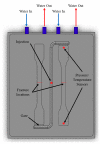A Novel Hybrid Foaming Method for Low-Pressure Microcellular Foam Production of Unfilled and Talc-Filled Copolymer Polypropylenes
- PMID: 31744195
- PMCID: PMC6918196
- DOI: 10.3390/polym11111896
A Novel Hybrid Foaming Method for Low-Pressure Microcellular Foam Production of Unfilled and Talc-Filled Copolymer Polypropylenes
Abstract
Unfilled and talc-filled Copolymer Polypropylene (PP) samples were produced through low-pressure foam-injection molding (FIM). The foaming stage of the process has been facilitated through a chemical blowing agent (C6H7NaO7 and CaCO3 mixture), a physical blowing agent (supercritical N2) and a novel hybrid foaming (combination of said chemical and physical foaming agents). Three weight-saving levels were produced with the varying foaming methods and compared to conventional injection molding. The unfilled PP foams produced through chemical blowing agent exhibited the strongest mechanical characteristics due to larger skin wall thicknesses, while the weakest were that of the talc-filled PP through the hybrid foaming technique. However, the hybrid foaming produced superior microcellular foams for both PPs due to calcium carbonate (CaCO3) enhancing the nucleation phase.
Keywords: TecoCell®, MuCell®, talc; calcium carbonate; foam-injection molding; polypropylene.
Conflict of interest statement
The authors declare no conflict of interest.
Figures









References
-
- Gong S., Yuan M., Chandra A., Kharbas H., Osorio A., Turng L.S. Microcellular injection molding. Int. Polym. Process. 2005;20:202–214. doi: 10.3139/217.1883. - DOI
-
- Baldwin D.F., Park C.B., Suh N.P. An extrusion system for the processing of microcellular polymer sheets: Shaping and cell growth control. Polym. Eng. Sci. 1996;36:1425–1435. doi: 10.1002/pen.10537. - DOI
-
- Zhang H., Rizvi G.M., Park C.B. Development of an extrusion system for producing fine-celled HDPE/wood-fiber composite foams using CO2 as a blowing agent. Adv. Polym. Technol. 2004;23:263–276. doi: 10.1002/adv.20016. - DOI
-
- Lee S.-T., Park C.B. Foam Extrusion: Principles and Practice. 2nd ed. CRC Press; Boca Raton, FL, USA: 2014.
-
- Suh N.P. Impact of microcellular plastics on industrial practice and academic research. Macromol. Symp. 2003;201:187–202. doi: 10.1002/masy.200351122. - DOI
Grants and funding
LinkOut - more resources
Full Text Sources
Miscellaneous

